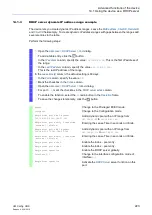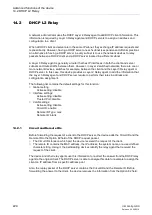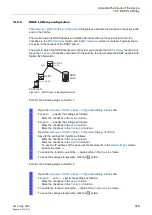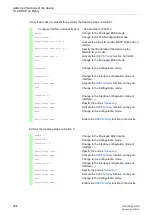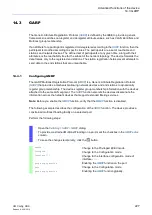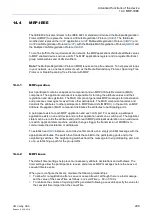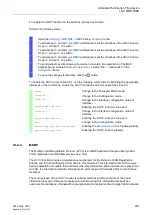
Advanced functions of the device
14.1
Using the device as a DHCP server
221
UM Config GRS
Release
8.0
09/2019
14 Advanced functions of the device
14.1
Using the device as a DHCP server
A DHCP server ("Dynamic Host Configuration Protocol") assigns IP addresses, Gateways, and
other networking definitions such as DNS and NTP parameters to clients.
The DHCP operations fall into 4 basic phases: IP discovery, IP lease offer, IP request, and IP lease
acknowledgment. Use the acronym DORA which stands for Discovery, Offer, Request, and
Acknowledgement to help remember the phases. The server receives client data on UDP port 67
and forwards data to the client on UDP port 68.
The DHCP server provides an IP address pool or "pool", from which it allocates IP addresses to
clients. The pool consists of a list of entries. An entry defines either a specific IP address or an IP
address range.
The device lets you activate the DHCP server globally and per interface.
14.1.1
IP Addresses assigned per port or per VLAN
The DHCP server assigns a static IP address or dynamic range of IP addresses to a client
connected to a port or a VLAN. The device lets you create entries for either a port or a VLAN. When
creating an entry to assign an IP address to a VLAN, the port entry grays out. When creating an
entry to assign an IP address to a port, the VLAN entry grays out.
Static allocation means that the DHCP server assigns the same IP address to a specific client. The
DHCP server identifies the client using a unique hardware ID. A static address entry contains 1 IP
address, and applies it to a port or VLAN on which the server receives a request from a specific
client. For static allocation, create a pool entry for the ports or one specific port, enter the IP
address, and leave the
Last IP address
column empty. Specify a hardware ID with which the DHCP
server uniquely identifies the client. This ID is either a MAC address, a client ID, a remote ID, or a
circuit ID. When a client contacts the server with the configured hardware ID, the DHCP server
allocates the static IP address.
The device also lets you assign a dynamic IP address range to ports or VLANs from which the
DHCP server allocates a free IP address from a pool. To add a dynamic pool entry for the ports or
VLANs, specify the first and last IP addresses for the IP address range, leaving the
MAC address
,
Client ID
,
Remote ID
, and
Circuit ID
columns empty. Creating multiple pool entries lets you have IP
address ranges that contain gaps.
Summary of Contents for GREYHOUND GRS1020
Page 8: ......
Page 16: ......
Page 146: ......
Page 232: ......
Page 310: ......
Page 330: ......
Page 338: ...Readers Comments 337 RM GUI GRS Release 8 0 09 2019 ...
Page 339: ......
Page 340: ......
Page 350: ......
Page 354: ......
Page 617: ...Readers Comments 277 UM Config GRS Release 8 0 09 2019 ...
Page 618: ......
Page 619: ......

















